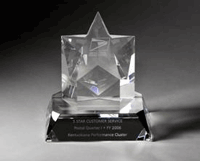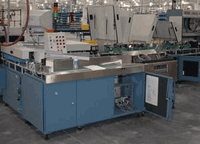24-hour clock keeps USPS linked
 "There are no islands in
the Postal Service. All of our
processes are linked. If you
do one well, you're going to
do well in another, and
another, and another." "There are no islands in
the Postal Service. All of our
processes are linked. If you
do one well, you're going to
do well in another, and
another, and another."
That's how Deputy
Postmaster General Pat
Donahoe illustrates the importance of the 24-hour clock
to our mail operations - to better manage our time, keep
the mail moving and give our customers the service they
depend on.
Meeting commitments by deadline helps the next
shift - or the next plant or Post Office further down the
mailstream - meet its deadlines too. Key indicators to help
us use the 24-hour clock are:
• All carriers back by 1800 (6 P.M.).
• Cancel 80 percent of collection mail by 2000 (8 P.M.).
• Process outgoing primary-sort mail by 2300 (11 P.M.).
• Process outgoing secondary-sort mail by 2400
(midnight).
• Clear Managed Mail Program (MMP) mail by 2400.
Zero MMP at 2400 (midnight).
• Assign commercial/FedEx outgoing mail by 0230
(2:30 A.M.).
• Process all delivery point sequence (DPS) second-
pass mail by 0700 (7 A.M.).
• Dispatch mail on time from plants to delivery units
0400-0900 (4-9 A.M.).
5 Star Customer Service award winners
announced
 The Postal Service
has announced the first-
ever 5 Star Customer
Service winners! The Postal Service
has announced the first-
ever 5 Star Customer
Service winners!
Eleven performance
clusters and 870 Post
Offices earned recognition for their Quarter 1
customer service efforts.
Clusters and offices were rated on a combination of residential and small business Customer Satisfaction
Measurement (CSM) survey questions.
Performance clusters were grouped in five categories -
Diverse and Crowded Cities, Established Cities, Cities in
Open Spaces, Smaller and Older Towns, and Room to
Grow. Winning clusters will receive a crystal star, winning
Post Offices will receive a door cling and employees in
those offices will receive lapel pins.
The winning performance clusters of the first-ever 5 Star
Customer Service awards are: Boston, Capital, Northern
New Jersey, Northern Virginia, Massachusetts, Southeast
Michigan, Southeast New England, Spokane, Albany,
Western New York and Kentuckiana.
Congratulations to all the winners! For the listing of 5
Star scores, go to http://blue.usps.gov/caweb/ckm/ckm_5star_welcome.htm.
NetLibrary lets you read eBooks on the
go
Imagine being able to reference and research current
business publications from the comfort of your or
while on travel.
Now you can. The Corporate Library is pleased to
announce the unveiling of NetLibrary - a new eBook collection. With NetLibrary, USPS employees have access to
more than 4,000 digital versions of some of the more recent,
highly recommended business and corporate management
titles available. NetLibrary's eBooks can be accessed either
from the Library's NetLibrary reference at http://blue.usps.gov/library/ or directly at www.netlibrary.com.
|
Any postal employee with browser access to the Postal
Service Intranet can register, borrow a book and use it immediately - rather than waiting for it to be mailed out. And
once you've registered through Blue, you can go directly to
the NetLibrary site from your own !
Try NetLibrary eBooks today. If you have any questions
or comments, contact the Corporate Library at
202-268-2904.
The long and winding WebROADS: New
database provides better REC overview
Remote encoding centers (RECs) started as a solution
for unreadable letter mail but evolved into an integral part of
our processing operations. Today's RECs process images
for not only letters but also flats, parcels, undeliverable-as-
addressed mail and change-of-address forms. Standardizing all of those operations was a challenge - until now.
Web REC Operations Analysis Database System
(WebROADS) started in fiscal year 2005 as a way to provide REC performance reports to national users across all
platforms. The latest software update gives craft group
leaders, supervisors and managers a better view of what's
happening at the REC. That's a big help when 70 percent of
your workforce schedules may change week to week
based on expected image arrivals.
Since the database works across all platforms, groups
such as Engineering, area coordinators and Headquarters
are able to access the application online to use in decision
analysis reports, software updates validation, REC performance and costs comparison, holiday planning and
contingency plans.
WebROADS is a good road to follow during this challenging budget year for the Postal Service.
Sum of all year: There's a reason it's
called comprehensive
It's not just for Congress.
It's for you, too.
Each year, the Postal
Service publishes its Comprehensive Statement on Postal
Operations to keep U.S.
lawmakers informed about
USPS plans, policies, operations, finances and other data.
Want to stay "in the loop?"
The 2005 edition is available
on the Postal Service Intranet
and USPS.com at www.usps.com/strategicplanning/cs05/.
The comprehensive statement does more than just add
up the stats. It puts the year in context - what we've been
doing and why we're doing it. You may know what your
group is doing to reduce costs and improve service, but
what about everybody else? The comp statement adds it
up for you.
Congress may read about it - but we live it. Knowing
everything we can about the place where we work can only
help us better do our jobs - and better serve our
customers.
New delivery mail sorters deployed
 State-of-the-art delivery
barcode sorter input output
subsystem (DIOSS) machines
are being deployed to replace
outdated multi-line optical
character readers (MLOCRs)
around the country. The new State-of-the-art delivery
barcode sorter input output
subsystem (DIOSS) machines
are being deployed to replace
outdated multi-line optical
character readers (MLOCRs)
around the country. The new
machines will deliver improved performance, handle a
wider range of mail types and provide more than 200 separations in the same space that MLOCRs currently occupy to
handle 60.
Two years in the testing, various configurations have
been completed in Ft. Worth, TX, Baltimore, MD, Sacramento, CA, Santa Clarita, CA, and Colorado Springs, CO.
The final configuration completed testing recently in
Queens, NY.
DIOSS Program Director Lilo Rheinstein said that a total
of 395 new DIOSS systems and 217 updates to existing
delivery barcode sorters will be deployed to 283 sites,
replacing 646 MLOCRs in the next 16 months. "The
remaining sites can expect to begin receiving the new
equipment by mid-March," Rheinstein said. |
